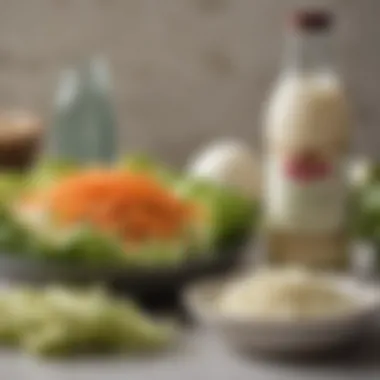Coleslaw with Vinegar and Mayo: A Culinary Exploration


Intro
Coleslaw, a dish often overshadowed by more elaborate salads, merits a closer examination. It embodies a harmonious balance between crunch and creaminess, particularly when prepared with the contrasting flavors of vinegar and mayonnaise. The humble cabbage becomes a canvas for numerous ingredients, and this exploration invites you to appreciate the simplicity and depth of coleslaw.
Traditionally, coleslaw has roots that stretch across various cultures, adapting and evolving over centuries. Its presence in modern culinary practices often sparks lively debates regarding the best ingredients and preparation methods. This article intends to illuminate these facets by detailing the preparation of coleslaw with vinegar and mayo, shedding light on its significance in both home cooking and restaurant menus.
Recipe Overview
Brief description of the dish
Coleslaw with vinegar and mayonnaise offers a refreshing yet tangy side dish that pairs beautifully with barbecued meats, sandwiches, and more. The combination of crisp vegetables and a creamy dressing provides a textural contrast that enhances the dining experience. While many variations exist, the core essence remains the same: a simple yet flavorful mix that can cater to different taste preferences.
Origin and cultural significance
The origins of coleslaw can be traced back to ancient times, with references found in Roman cooking that included cabbage mixed with eggs and vinegar. Over the years, it has transformed, particularly in the United States, where mayonnaise emerged as a leading ingredient. In various cultures, coleslaw serves as a staple at gatherings, celebrating its versatility across different cuisines. Today, it is not merely a side dish; it carries cultural significance often associated with summer picnics and festive occasions.
Ingredients List
To create a flavorful coleslaw with vinegar and mayo, a thoughtful selection of ingredients is key. Below is a comprehensive list of essentials:
- Green cabbage: 1 medium head, finely shredded
- Carrots: 2 medium, grated or julienned
- Mayonnaise: 1 cup (homemade or store-bought)
- Apple cider vinegar: 2 tablespoons
- Sugar: 1 tablespoon
- Salt: 1 teaspoon
- Black pepper: to taste
- Optional additions:
- Celery seeds: 1 teaspoon for an extra crunch
- Onion: finely chopped for added flavor
Special ingredient notes
In choosing ingredients, fresh produce yields the best flavor and texture. Both green and purple cabbage can be utilized for diverse visual appeal. If you are looking for healthier options, you might consider Greek yogurt as a substitute for mayonnaise. Additionally, local farmers' markets often offer fresher produce, enhancing the overall quality of your coleslaw.
In summary, understanding the preparation and cultural heritage of this quintessential dish elevates the cooking experience, inspiring cooks of all backgrounds to explore and enjoy coleslaw with vinegar and mayo.
Understanding Coleslaw
Coleslaw is more than just a side dish; it has a rich history and a versatile nature that makes it significant in various culinary landscapes. At its core, coleslaw is a mixture that typically includes shredded cabbage and a dressing, which in this exploration will focus on vinegar and mayonnaise. This combination of ingredients brings together contrasting flavors and textures, providing a unique culinary experience that can be tailored to individual preferences.
Definition and Origins
Coleslaw, originating from the Dutch word "koolsla" which translates to "cabbage salad," plays an important role in many cuisines today. The dish likely evolved in Northern Europe, specifically in the Netherlands, where cabbage was a staple in the diet due to its ability to be stored for long periods. As European settlers came to America, they brought coleslaw recipes with them, adapting the dish using locally available ingredients.
Typically, coleslaw consists of shredded raw cabbage, seasoned with a dressing that can vary from simple vinegar solutions to more complex creamy dressings like mayonnaise. The earliest recipes involved vinegar, sugar, and oil, which reflected the available local ingredients and the preservation methods used during those times. Today, coleslaw serves not just as a side dish, but also as a complement to various meats and sandwiches, showing how its role has evolved over time.
Cabbage: The Core Ingredient
Cabbage is an essential component of any coleslaw. Its crisp texture and natural sweetness create the perfect base for various dressings. There are several types of cabbage that can be used, including green cabbage, red cabbage, and savoy cabbage. Each type offers different textures and flavors, allowing cooks to experiment with their preferred choice.
- Green Cabbage: This is the most common type used for coleslaw. It has a mild flavor, which works well with a range of dressings.
- Red Cabbage: This adds vibrant color and is slightly peppery, providing a contrast in taste and appearance.
- Savoy Cabbage: Known for its crinkly leaves, savoy cabbage offers a sweeter and milder taste, making it ideal for a lighter coleslaw.
The choice of cabbage does not just affect taste, but also the nutritional profile of the dish. Cabbage is low in calories and rich in vitamins C and K, making it a healthy addition to any meal. Incorporating a variety of cabbages can enhance the visual appeal and provide a range of flavors, making coleslaw a more engaging dish.
In summary, understanding coleslaw's definition and its core ingredient, cabbage, is crucial for anyone looking to create a successful version of this dish. These elements set the stage for deeper exploration into the flavors provided by vinegar and mayonnaise, along with the techniques that can elevate simple coleslaw into a remarkable culinary experience.
Vinegar and Mayo: A Flavor Profile
In the realm of coleslaw, vinegar and mayonnaise serve as the two main elements that define its taste and texture. Their relationship creates a balance between sharpness and creaminess. This section examines these components, considering their impact on overall flavor.
Understanding Vinegar Varieties


Vinegar offers a spectrum of flavors that can profoundly alter coleslaw's profile. There are several types of vinegar, each bringing a unique taste:
- Apple Cider Vinegar: Known for its fruity undertones, this vinegar adds a sweeter, milder acidity.
- White Vinegar: With its sharp and clean flavor, this type provides a straightforward tang, making it a common choice in many recipes.
- Rice Vinegar: Less acidic and slightly sweet, rice vinegar can lend a gentler flavor sensation.
- Balsamic Vinegar: This dark, syrupy option introduces a complex sweetness and depth. It works well when blended in small quantities.
When selecting vinegar for coleslaw, consider the desired flavor outcome. A delicate apple cider vinegar can enhance the natural sweetness of the cabbage, while the brightness of white vinegar might contrast nicely with the creaminess of mayonnaise.
Mayonnaise: A Creamy Complement
Mayonnaise is more than just a thickener; it is critical in achieving the desired creaminess in coleslaw. When crafted appropriately, it binds the ingredients together and tempers the sharpness of vinegar. A well-made mayonnaise incorporates vegetable oil, egg yolk, and acid, usually vinegar or lemon juice. This combination not only provides smooth texture but also enhances flavor through a rich mouthfeel.
It's possible to experiment with different types of mayonnaise:
- Regular Mayonnaise: A classic choice that balances the tanginess of the vinegar effectively.
- Greek Yogurt: Using Greek yogurt as a substitute results in a lighter, tangy variant, appealing to those looking for healthier options.
- Vegan Mayonnaise: Made with plant-based ingredients, it caters to those with dietary restrictions while preserving creaminess.
Both vinegar and mayonnaise play vital roles in coleslaw, and understanding their nuances can enrich the cooking experience. Through selecting appropriate types and balancing their ratios, one can create a coleslaw that is not only flavorful but also memorable.
Preparation Techniques
Understanding proper preparation techniques is crucial when making coleslaw with vinegar and mayonnaise. This phase is not just about following steps; it underpins the overall flavor, texture, and presentation of the dish. Appropriate techniques can elevate a simple coleslaw into a delightful culinary experience. The mastery of these skills ensures consistent results, increases efficiency, and enhances the enjoyment of the cooking process.
Mise en Place: Gathering Ingredients
Mise en place is the first step in the cooking process. This French term translates to "everything in its place," and it emphasizes the importance of organizing ingredients before beginning. For coleslaw, this includes various types of cabbage, vinegar, mayonnaise, and any additional ingredients like carrots or herbs. Ensuring that all items are prepped and within reach streamlines the process and minimizes the likelihood of mistakes.
By gathering fresh ingredients, the cook also ensures optimal flavor and texture. Purchasing high-quality mayonnaise, such as Hellmann's or Duke's, can significantly influence the final taste of the coleslaw. When vinegar is included, consider varieties like apple cider or red wine. These choices add depth to the overall flavor profile.
Shredding Cabbage Properly
The cabbage shreds serve as the backbone of coleslaw, requiring careful attention. The method of shredding directly impacts the dish's texture. A knife, food processor, or box grater can be used; each has its advantages. When using a knife, the cabbage should be cut into quarters, and then each quarter should be finely sliced. Uniform pieces ensure even distribution of dressing in each bite.
Using a food processor can speed up the process, but it is essential to avoid over-processing, which results in mushy cabbage. Keep in mind that the freshness of the cabbage is also vital; wilted leaves can lead to a lackluster dish. Fresh, crunch cabbage is critical to a pleasing texture.
Mixing Vinegar and Mayo
The final step in preparation is mixing vinegar and mayonnaise to form the dressing. The balance between tanginess and creaminess is crucial. A typical ratio might begin with a base of one-part vinegar to three-parts mayo, but this can be adjusted to taste. When combining these ingredients, it is advisable to use a whisk, as it allows for better emulsification.
Incorporating additional elements like mustard or honey can further enhance the flavor. Drizzling in the vinegar gradually while whisking can help ensure a uniform mix. The texture of the dressing should be creamy but not overly thick.
The creativity in this part of preparation reflects personal tastes, so experimentation is encouraged. Each mix leads to a unique dish, ensuring that every iteration of coleslaw becomes a new adventure.
"Great cooking is about both technique and creativity. Mastering preparation leads to better dishes."
By focusing on these preparation techniques, you set the stage for a successful coleslaw that balances flavor, texture, and overall appeal.
Ingredient Variations
Ingredient variations play a crucial role in the culinary versatility of coleslaw. The ability to adapt and modify recipes not only brings freshness to an otherwise simple dish but also allows for personalization according to taste preferences and nutritional needs. By experimenting with different ingredients, cooks can enhance the flavor profile, texture, and visual appeal of coleslaw, making it a more dynamic addition to any meal.
One significant benefit of adding variations is the opportunity to incorporate seasonal produce. Fresh vegetables and fruits can elevate the dish, providing a burst of color and nutrients. For example, adding shredded carrots, diced apples, or sliced bell peppers introduces new textures and flavors. These variations not only diversify the dish but also align with a balanced diet, allowing the dish to appeal to health-conscious individuals.
Moreover, variations create a platform for cultural expression. Regional ingredients can be used to connect the dish to local customs or tastes. This a gourmet approach can entice food enthusiasts to explore the roots of each ingredient, appreciating how different cuisines interpret the concept of coleslaw.
Adding Vegetables and Fruits
Incorporating additional vegetables and fruits into coleslaw is an art that invites creativity. Common choices include carrots, which add a sweet crunch, and red cabbage, providing a pop of color. These additions work harmoniously with the main ingredient, cabbage, fostering a balanced combination of flavors.


Fruits, such as pineapple or apples, introduce a subtle sweetness that contrasts beautifully with the tangy vinegar and creamy mayonnaise. This balance can transform a simple coleslaw into a vibrant side dish. The trick is to maintain harmony among the different tastes while ensuring that the texture remains appealing.
When adding vegetables or fruits, consider the following:
- Flavor compatibility: Ensure the characteristics of new ingredients complement the existing flavors.
- Texture: Balance crunch with softness for an interesting mouthfeel.
- Nutritional value: Aim for a mix that supports health benefits, adding more vitamins and minerals.
Alternative Dressings
While vinegar and mayonnaise are traditional dressings for coleslaw, alternative dressings can introduce diverse flavors and cater to various dietary preferences. For instance, yogurt-based dressings can reduce fat content while still delivering creaminess, appealing to those seeking a healthier option.
Similarly, vinaigrettes, made with olive oil and various kinds of vinegar, like balsamic or apple cider, offer a lighter alternative that enhances the natural crispness of the vegetables. Just as traditional coleslaw varies by region, so does the range of dressings that can be utilized.
Consider trying:
- Greek yogurt: Provides creaminess along with probiotics.
- Hummus: A unique alternative offering rich flavors and a vegan-friendly profile.
- Mustard-based dressings: Introduce a spicy kick to coleslaw.
In addition to flavor diversity, alternative dressings also reflect dietary trends, making coleslaw more inclusive for various eating lifestyles. This ability to adapt not only enhances the dish but also enriches the overall dining experience. Ultimately, experimenting with various ingredients and dressings paves the way for unique culinary creations.
Nutritional Aspects
Understanding the nutritional aspects of coleslaw with vinegar and mayonnaise is crucial for various reasons. First, it addresses health concerns and dietary choices for individuals. Second, it highlights the balance of flavors and textures that different ingredients contribute. A well-crafted coleslaw not only delights the palate but can also offer health benefits depending on the ingredient choices.
Caloric Content Considerations
When evaluating coleslaw's caloric content, several factors come into play. A simple recipe may consist mainly of cabbage, vinegar, and mayonnaise. The cabbage is low in calories, about 25 calories per cup when raw. On the other hand, mayonnaise can significantly increase the caloric value due to its fat content. For those watching their calorie intake, it is advisable to use reduced-fat mayo or even alternatives like Greek yogurt to maintain creaminess with fewer calories.
It is also essential to consider portion sizes. Coleslaw is often served as a side dish, and serving sizes can impact total caloric intake. Here are a few points to remember:
- Cabbage contributes significantly fewer calories.
- Mayonnaise is dense in calories.
- Homemade dressings allow better control over calorie content.
- Serving size impacts overall nutrient consumption.
In summary, making informed choices about portion sizes and ingredient types can help manage caloric intake effectively.
Health Benefits of Ingredients
Coleslaw incorporates various ingredients that provide distinct health benefits. The primary ingredient, cabbage, is rich in vitamins K and C, both of which play important roles in the body. Vitamin K is crucial for bone health and helps in blood clotting, while vitamin C is an antioxidant that supports the immune system.
Other health benefits include:
- Fiber-Rich Content: Cabbage is high in fiber, promoting digestive health and aiding in weight management.
- Healthy Fats: Using avocado oil mayo instead of traditional mayonnaise can enhance the health profile by introducing more monounsaturated fats, which are beneficial for heart health.
- Natural Flavors and Nutrients: Adding vegetables like carrots or bell peppers increases the nutrient density and provides additional vitamins and minerals.
"Choosing fresh and quality ingredients informs the nutritional profile of coleslaw, ensuring it serves as not just a tasty dish but a healthy option as well."
Incorporating these ingredients thoughtfully leads to a coleslaw that is both delicious and packed with nutrients, making it a worthy addition to any meal.
Cultural Contexts
The cultural contexts surrounding coleslaw highlight its significance in various culinary traditions. This section dives into how coleslaw serves not just as a side dish but as a cultural emblem. The dish varies dramatically across regions, embodying local customs, flavors, and preferences. By understanding these differences, we gain insight into the global appreciation of coleslaw with vinegar and mayonnaise.
Coleslaw in American Cuisine
In American cuisine, coleslaw is almost ubiquitous at picnics, barbecues, and family gatherings. It often accompanies fried chicken and pulled pork, providing balance to rich, savory dishes. The creamy texture from mayonnaise combined with the acidity of vinegar creates a dynamic flavor profile that appeals to many.
The origins of coleslaw in the United States date back to the early 18th century. It adapted from European preparations, primarily influenced by Dutch settlers who introduced cabbage and sauce combinations.
Today, regional variations exist in American coleslaw recipes. Some areas prefer a sweeter version with sugar, while others like it spicier, incorporating ingredients like jalapeños. Furthermore, coleslaw has become a staple for various events ranging from casual family meals to formal occasions, demonstrating its versatile role as a salad.


International Variants of Coleslaw
Globally, different cultures have their interpretations of coleslaw. For example:
- Latin America: Here, coleslaw often includes lime juice and cilantro, giving it a fresh and zesty taste, distinct from the American style.
- Korea: Known as "kkakdugi," a type of kimchi, this version features cubed radishes and a spicy pepper sauce.
- Germany: The German variation incorporates caraway seeds and vinegar, focusing on a tangy and slightly herbal profile.
Each version holds culinary significance, reflecting local tastes and traditions. The diverse adaptations of coleslaw showcase how a simple dish can take on a myriad of forms, appealing to various palates and preferences.
Coleslaw transcends cultural boundaries, demonstrating that even the simplest combinations of ingredients can create profound connections across different cuisines.
Serving Suggestions
In the culinary world, serving suggestions play a crucial role in elevating a dish, particularly one as versatile as coleslaw made with vinegar and mayo. They offer valuable guidance on how to complement and enhance flavors while also providing insights into the context in which a dish can be enjoyed. This section will discuss the ideal accompaniments and presentation techniques that can transform a simple coleslaw into a highlight at any meal.
Perfect Pairings
When it comes to pairing dishes, coleslaw with vinegar and mayo truly shines. Its balance of creaminess and tanginess allows it to harmonize with a wide array of flavors. Here are some perfect pairings:
- Grilled Meats: The acidity from the vinegar cuts through the richness of grilled chicken or pork. It adds a refreshing contrast, making the overall meal more dynamic.
- Sandwiches: Coleslaw serves as an excellent side to sandwiches, especially those with strong flavors. A pulled pork sandwich becomes even more delightful when paired with tangy slaw.
- Fish Dishes: Lightly battered fried fish or grilled salmon can benefit from a small serving of coleslaw, providing texture and enhancing the dish’s brightness.
- Tacos: Slaw offers a crunchy, cool counterpart to spicy tacos, balancing the heat and adding layers of flavor.
This versatility makes coleslaw a staple in various meal contexts, from barbecues to casual family dinners.
Presentation Techniques
How coleslaw is presented can greatly affect perception and enjoyment. Here are some effective techniques:
- Color Contrast: Utilize different colored cabbages, such as purple and green. It adds visual interest and reinforces the appeal of freshness.
- Layering: Serve coleslaw in a clear glass bowl. This highlights the different textures and colors, making it visually striking and inviting.
- Garnishing: Fresh herbs like parsley or dill add a pop of color and flavor. A sprinkle of sesame seeds can elevate the presentation.
- Portioning: Consider using individual bowls or jars for servings. This not only looks appealing but also makes it easy for guests to enjoy.
By implementing these serving suggestions, cooks can enhance the experience of enjoying coleslaw, ensuring it becomes a memorable part of the meal. \n
"The way a dish is presented can change the way we experience it. Beautiful presentation can elevate even the simplest dishes into something special."
Attention to detail in serving and presentation can transform coleslaw into more than just a side dish; it can become a conversation starter at the table.
The End
Understanding the significance of coleslaw, particularly the version made with vinegar and mayonnaise, wraps this exploration in a larger context. It reflects not just culinary preference but culture, history, and the evolution of dishes across time. In this article, we unpack the multifaceted nature of coleslaw. It is essential to recognize how versatile this dish can be, easily adapting to various tastes, dietary needs, and cuisines.
A notable aspect is its ability to merge the tangy brightness of vinegar with the creamy texture of mayonnaise. This balance caters to both those seeking a lighter side dish and those preferring a richer flavor profile. Every cook benefits from realizing that the recipe can be a canvas for creativity rather than just a standard item on the menu.
By emphasizing the importance of these ingredients, we discover the broader culinary possibilities. Opting for different types of cabbages or adding various herbs can create unique variations that resonate with personal or regional preferences.
Coleslaw stands as a testament to the joys of cooking: it invites exploration and adaptation. Each element—from the base ingredient to the preparation technique—plays a role in crafting a dish that is both familiar and novel. Thus, embracing the versatility of coleslaw encourages cooks of all talents to engage deeply with the recipe. This process not only enhances culinary skills but also fosters an appreciation for the humble beginnings of a dish that has evolved significantly.
Embracing Versatility
The versatility of coleslaw cannot be overstated. Traditionally viewed as a straightforward side dish, it opens doors to numerous interpretations. With just cabbage, vinegar, and mayo, a cook can create myriad flavor profiles by altering ingredient combinations or dressings.
One can utilize different types of cabbage, such as green, red, or savoy, each imparting unique textures and tastes. Beyond vegetables, additions like apples, raisins, or shredded carrots can introduce sweetness while maintaining the balance of flavors. Different vinegars—apple cider, balsamic, or rice wine—elevate the tangy dimension, offering distinct notes that highlight the dish’s adaptability.
- Regional Variations: Exploring variations can enhance your experience. Southern coleslaw often leans on a sweeter profile, while New England versions may emphasize tanginess.
- Dietary Preferences: There is room to cater for diverse diets. For example, vegan mayo or yogurt can replace traditional mayonnaise, appealing to individuals with specific dietary restrictions.
Harmony in flavors is possible with diverse ingredients and preparation methods, making coleslaw a dish that can be modified for every occasion and audience.
Encouragement for Culinary Experimentation
Culinary experimentation rests at the heart of this exploration into coleslaw. While traditional recipes provide a foundation, it is creativity that should drive the cooking experience. Encourage yourself to step outside the typical boundaries of ingredients. Try integrating unusual additions: spices, nuts, or even different proteins.
- Try New Ingredients: Experimenting with colorful bell peppers, jalapeños, or fresh herbs adds visual appeal and complexity. You may find a zest that you never expected.
- Adjusting Proportions: Altering the amount of mayo or vinegar creates countless flavor variations. Inviting tastes of sweetness or spice can lead to discovering personal favorites.
By being curious and brave in the kitchen, cooks can transform the ordinary act of preparing coleslaw into an engaging gastronomic adventure. Each attempt, regardless of outcome, contributes to heightened skills and a deeper understanding of flavors. As one becomes more comfortable with varying the recipe, it can become a signature dish that stands out in any meal.
So, do not hesitate to explore. The results may just lead to the next great variant of coleslaw that impresses family and friends alike.



